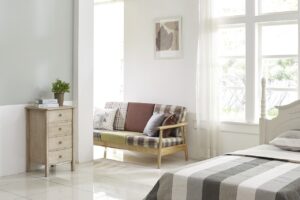
Often I get phone calls from new clients who’ve just moved into their first home from the city. When I ask what style appeals to them, they describe themselves as “super–modern.” I get really excited to work on an ultra-modern space, but when we actually meet, I find their favorite sofa has huge puffy cushions and block legs—super comfy, but not super modern.
So, what are the elements that define ultra-modern? The sofa is a great place to start, because it quickly defines the space: How do you feel about metal legs? How do you feel about a stunning, low-slung sofa with a seat height of 15 inches? (Standard seat height on a sofa is 18-19 inches…easier to get out of, but less modern.) How do you feel about tightly upholstered seats and/or backs that this gives your furniture clean, crisp lines?
Moving on to the coffee table: Can you live comfortably with glass and enjoy the weightlessness of it? Modern coffee tables (glass or otherwise) are 12–14 inches high to coordinate with low sofas, also if you want your sofa to look at its best, you should get services like sofa cleaning Singapore to help you with this. Will you feel at ease putting your feet up, reaching for your drink or snack, at this height?
Picture armless slipper chairs, simple wooden Scandinavian chair frames, a leather bench, and bold modern art. Can you live in a minimalist, pared-down setting and still feel at home? Or, do you enjoy having a wall of family photos to remind you of birthdays, trips, and other significant moments? Are you a collector of items like elephant figures, vintage food tins, ceramics? And do you enjoy displaying them? Do you want to dive onto a deep, squishy sleeper sofa, where you’re so comfy you have to keep asking people to deliver your drinks, phone, and pretzels, because you don’t want to get up? Critical to the modern aesthetic is the ability to edit, so all this is not to say that collections can’t be incorporated into a modern look, or that modern furniture won’t be comfortable, but these are the elements of pure modernism—the type we ogle at in magazines.
It turns out that most people who think of themselves as modern actually like what I call “Modified Modern.” I’m tired of the term, “transitional”—it’s too broad and feels really 1990’s. Modified Modern is my own term, so if you throw it around in Crate & Barrel, you may get a blank stare, but give it a try. What is Modified Modern? Picture a giant sectional with straight arms, a tight back, but super comfy seat cushions. (Note: This tight back would look super sleek, but actually be secretly super comfy.) Picture a chrome and leather chair. Leather chairs can last for decades when maintained with a leather conditioner. How about a giant coffee table that can handle feet and doesn’t need coasters? Add a giant art piece and textural rug and Voila! Modified Modern.
When speaking with residential remodeling contractors to plan a renovation project, defining your style is important as it will act as a guide to figuring out what you like, and what furniture styles flow well together. With most of my clients, I find ways to mix styles and periods to create a unique look in each home. But for those of you who prefer to decorate independently, this gives you some good guidelines on what makes up Modernism.
Tune in next month when I’ll write about “The New Traditionalism.” Until then—Happy Hunting!
Constance Hall is an interior designer and certified “furniture fanatic.” She‘s the owner of Constance Hall Design and can be reached at 914-238-6614 for all interior design needs.







